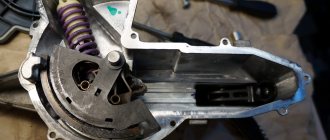On September 28, Russia celebrates Mechanical Engineering Day. The machine builders closest and most understandable to us work at AvtoVAZ. On the occasion of the holiday, “Another City” will tell about their wildest fantasies.
Text: Andrey Kochetkov
Over almost half a century of its existence, AvtoVAZ has developed many prototypes, concept cars, and cars that simply did not reach mass production. Some of them can now be seen in the AvtoVAZ Technical Museum in Tolyatti. Some now exist only in photographs. When you admire some of them, it becomes a pity that they did not go into series. And you won’t be able to take a closer look at them somewhere in a traffic jam on the Moscow Highway. Some models are amazing. After contemplating some of them, you want to lose yourself in the chaos of revelry on the Day. Some ideas were quite straightforwardly borrowed from foreign colleagues. Some were the fruits of their own Tolyatti imagination. In a word, this not the most famous part of AvtoVAZ’s developments looks as contradictory and ambiguous as the model range that went into series.
Representatives of which can be found on the roads of almost the entire planet. In honor of Mechanical Engineer's Day, we have selected 10 of the most interesting developments of AvtoVAZ, which you will never accidentally catch your eye.
VAZ-E1101
This cute dwarf, Tyrion Lannister from Game of Thrones, from the auto industry was born at the end of 1972. In the era when the “troika” was the last innovative development of “VAZ”, put into production. And the production of the Soviet tetralogy of cartoons about Cheburashka has not yet crossed the equator.
In fact, the alternative experimental version of the “penny” at the plant was named after the then-new cartoon character. The idea of a compact front-wheel drive car began back in 1968. As our own development, which is an alternative to the Fiat twins, whose mass production lasted at VAZ for another four decades. “Another Kopek”, made from scratch using semi-handicraft methods, remained a prototype forever. It could not compete with Fiat’s developments and did not go onto the production line. For example, a cute dwarf was passing gas into the cabin.
However, it was with “Cheburashka” that AvtoVAZ began its long thorny journey to develop its own car models that were not borrowed from overseas.
We are waiting for restyling
AvtoVAZ has already postponed the shutdown of the Lada Priora several times, a model that has been produced for more than ten years, and taking into account the fact that this model is a restyling of the famous “ten” (Lada 110), this car can be called a long-liver: in total 22 years in production.
But now the automaker has made up its mind: production of Priora is being discontinued. This is exactly what is stated in the letter to dealers, Vedomosti reports. The company's statement also states that in addition to Lada Priora, the production plan for the second half of this year does not include such models as Lada Granta and Kalina. It is noted that this is due to the so-called restyling of Granta in the X-style, as well as the fact that the hatchback and station wagon (including its cross-version) will later be included in the Granta line. No other details were provided in the letter.
In 2022, AvtoVAZ sold 311.6 thousand cars, 45% of which were sold under the state support program. The most popular car was Granta (93.7 thousand cars), second place went to Vesta (77.3 thousand), third place to Xray (33.3 thousand). At the same time, as Vedomosti writes, Priora sales are falling today, and the car is sold only as a sedan, even though it is one of the cheapest in the AvtoVAZ model range.
VAZ-2122 "River"
The most famous Soviet jeep “Niva” is currently considered in the world almost the main achievement of the domestic automobile industry. It’s not for nothing that it has been produced and sold for almost three decades; it’s time to consider it synonymous with “stability.” And it seems that the domestic jeep will still dance a jig on our graves.
Not surprisingly, there are several variations on the theme of the Soviet SUV. Some of them are quite exotic. VAZ-2122, nicknamed “River”, is the first and last amphibian created in Tolyatti. A car that moves by rotating its own wheels both on land and on water has never been mass-produced.
It’s a pity... The shoals of “Rivers” plowing the Volga distances with the Zhiguli Mountains as a background excite the imagination.
VAZ-1801 “Pony”
Like many Soviet technical developments, the VAZ-1801 is a fantasy about the products of the capitalist world. In 1969, the British Mini Moke arrived at VAZ, in which the chief designer drove the breeze around the plant.
After about 10 years, the plant developed its own version of the Briton. It was an electric car with two batteries, the charge of which was enough for 110-120 kilometers. The design of the appearance of the model, codenamed “Pony,” was carried out by the creator of the Oka exterior.
The Soviet electric car was supposed to be launched for the Moscow Olympics. But they didn’t have time to finish it on time. And then it was forgotten, having previously appeared at several automobile exhibitions. Which is no wonder... Why did the USSR need a golf cart? At that moment, the country was more interested in cars that would be convenient for transporting pumpkins from the countryside.
VAZ-2802-02 Pony
Here is a unique light-duty electric cargo vehicle created at the Volzhsky Automobile Plant. In the 80s, a single copy of the Pony prototype was designed. The original truck demonstrated a fundamentally new approach to the development of light-duty vehicles. In the process of creating it, engineers decided to abandon aluminum and lightweight structural materials. At the same time, they tried to make the steel frame as light as possible.
The main feature of the VAZ-2802-02 Pony was the electric motor located transversely in front of the driving rear axle. The basic package also included a spare wheel. A distinctive feature of the experimental truck's cabin was its vertical walls and large glass area. The instrument panel was located on the steering column. The steering wheel was initially made rectangular, but then changed to a standard one.
The space behind the cabin was used as a cargo platform, on which a closed cargo container of the required dimensions was installed. At the same time, the VAZ-2802-02 Pony had a number of disadvantages. In particular, the elimination of aluminum made the truck's design unreasonably heavy, resulting in a reduction in its load capacity. Among other things, the large glazing area did not allow opening windows. One hatch was not enough for full ventilation, and making an automatic ventilation system was not feasible from an economic point of view. As a result, it was decided to abandon the mass production of the VAZ-2802-02 Pony. The car was placed in the automobile plant museum.
VAZ-21073
One of the modifications of the “Seven”, created in the year of Kuibyshev’s 400th anniversary. Crazy fantasy on the Volvo design theme. In fact, this is an attempt to combine the “seven” and the details of the upcoming “eight”. Now the words “seven” and “eight” are more associated with Californian Windows and iOS. And then it was more about ours, the Volga...
VAZ-21073, by and large, was a design pampering. Because at that moment the best forces of the plant were already thrown into the serial launch of the Lada Sputnik.
LADA RAPAN
This miracle came to earth as if from a dream of Luc Besson who had had too much. The car is named after a predatory mollusk brought from the Far East to the Black Sea and which has currently devoured almost all the small fauna there. Rapan is an electric car, shown in 1998 after 12 long years of development. The car, whose controls are hidden in the steering wheel, was met with great curiosity at the Paris Motor Show. But this was just a case of “about seeing Paris and dying.”
AvtoVAZ wanted to attract RAO UES of Russia so that the holding would equip existing conventional gas stations with Rapanov charging devices. But in the diocese of Anatolia Chubais the idea did not cause delight. And the only “Rapan” in the world now stands in the hall of the AvtoVAZ management, and Tesla electric cars from Silicon Valley drive on the roads of the world.
LADA OKA-2
A small car of a new generation of domestic production, which is so lacking on our congested roads, was even produced at AvtoVAZ. But they made Oka-2 in the mid-2000s, only 10 of them. And something went wrong...
KamAZ and SeAZ were interested in the new Oka. Yuri Luzhkov wanted to launch its production at the idle facilities of ZIL. But all these plans turned into decay. And now Oka-2, like the Yo-mobile, has become a beautiful but sad page in the history of our automotive industry.
VAZ-2120 “Nadezhda”
The first domestically produced minivan was made at the experimental production of Avtovaz from 1998 to 2006. They managed to make as many as 8,000 “Nadezhda” products. But domestic consumers did not feel much faith or love for them. They were called obsolete and unreasonably expensive.
The quote “gives the impression of a car assembled from spare parts from different models” says almost everything about Nadezhda.
However, the “twenties” also have their fans. Like everything made on the basis of Niva.
"Lada" is no longer the same...
As the media note, in today's modifications Lada Priora and Lada Kalina are no longer so popular; the cars did not even make it into the Top 25 most purchased car models in Russia in the first four months of this year. As for the Lada Granta, this model ended up in third place in the ranking (about 28 thousand units were sold in 2022), losing second place to AvtoVAZ’s current bestseller, the Lada Vesta.
Let us remind you that today Lada Granta, Lada Kalina and Lada Priora are among the most budget car options of AvtoVAZ. Official dealers sell them at prices ranging from 369,900 rubles, 420,600 rubles. and 424,900 rub. respectively. The plant has been producing Lada Priora since 2007, and the millionth copy of this model rolled off the assembly line on April 21 last year.
LADA-2151
A concept also shown at the Moscow Motor Show in 2002. Such cars, according to the ideas of their creators, were supposed to replace the VAZ “classics”.
At first we plan to call the car “Strezhen”. But this name was cut down because the Russian letter “Zh” was inconvenient for promotion on the world market. As a result, the 51st Lada was called “Neoclassic”. But the “ecological niche” of “Neoclassics” in the model line. And the 51st remained just a rather successful fantasy of factory designers and constructors.
When will we see the new Lada Granta
As the AUTOSTAT agency reports with reference to Lada dealers, production of the restyled Granta family is planned to begin this August. Now we will talk about four body types: sedan, liftback, hatchback and station wagon. As a result, the Kalina model will cease to exist.
The so-called “restyling family” of Lada Granta is planned to be presented at the Moscow Motor Show 2018. Also, as the media recalls, at the end of 2015, AvtoVAZ stopped the production of Lada Priora hatchbacks and station wagons, while keeping only the sedan on the assembly line, since approximately 80% of sales were accounted for by this body type.
At the same time, as noted, the market positioning of the Priora sedan changed: starting in 2016, it began to be produced with a less powerful engine and simplified equipment, thanks to which it was possible to reduce the price of the model and maintain demand for it. Moreover, this was directly related to the launch of the new flagship model Lada Vesta on the market, the mission of which was initially to replace Priora.











